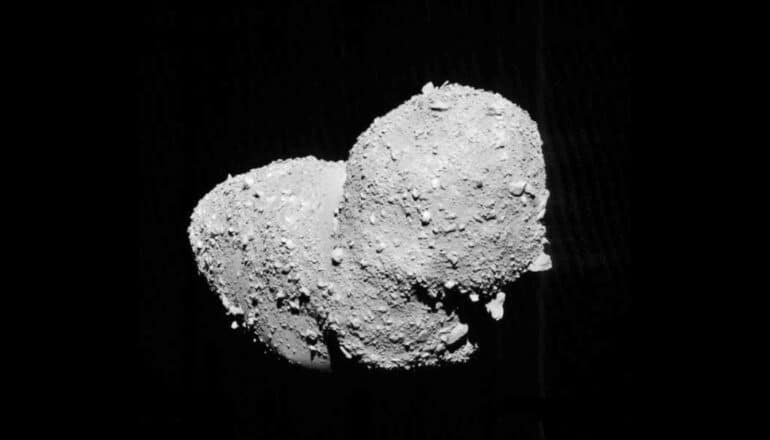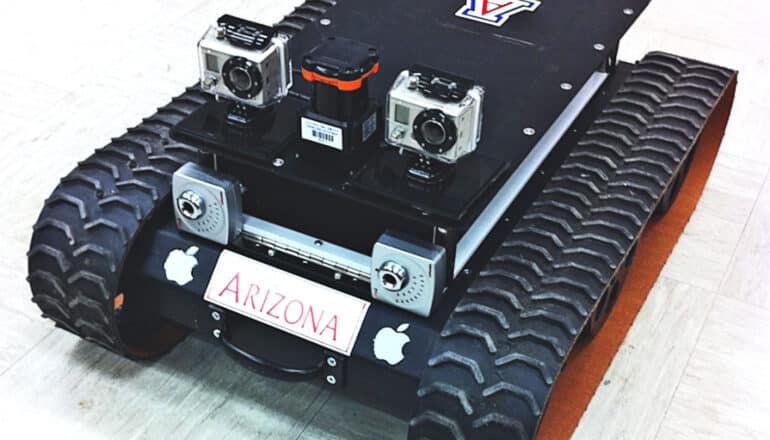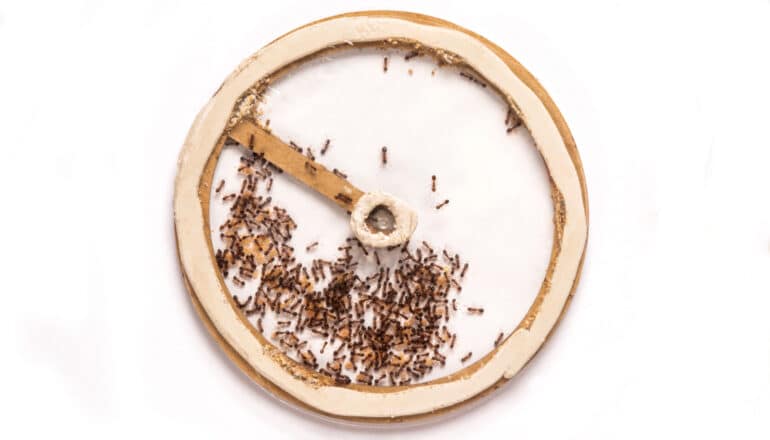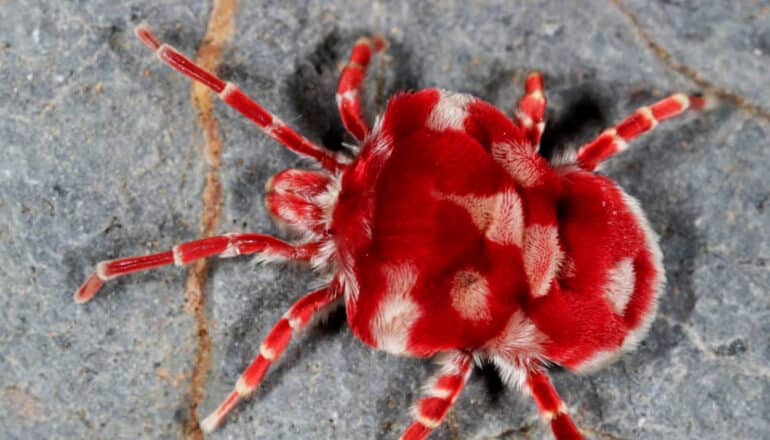
The discovery of tiny salt grains in an asteroid sample provides strong evidence that liquid water may be more common in the solar system’s largest asteroid population than previously thought.
The smattering of tiny salt crystals discovered in a sample from an asteroid has researchers excited, because these crystals can only have formed in the presence of liquid water.
Even more intriguing, according to the research team, is the fact that the sample comes from an S-type asteroid, a category known to mostly lack hydrated, or water-bearing, minerals. The discovery strongly suggests that a large population of asteroids hurtling through the solar system may not be as dry as previously thought. The finding, published in Nature Astronomy, gives renewed push to the hypothesis that most, if not all, water on Earth may have arrived by way of asteroids during the planet’s tumultuous infancy.
“Once these ingredients come together to form asteroids, there is a potential for liquid water to form.”
Tom Zega, the study’s senior author and a professor of planetary sciences at the the University of Arizona Lunar and Planetary Laboratory, and Shaofan Che, lead study author and a postdoctoral fellow at the Lunar and Planetary Laboratory, performed a detailed analysis of samples collected from asteroid Itokawa in 2005 by the Japanese Hayabusa mission and brought to Earth in 2010.
The study is the first to prove that the salt crystals originated on the asteroid’s parent body, ruling out any possibility they might have formed as a consequence of contamination after the sample reached Earth, a question that had plagued previous studies that found sodium chloride in meteorites of a similar origin.
“The grains look exactly like what you would see if you took table salt at home and placed it under an electron microscope,” Zega says. “They’re these nice, square crystals. It was funny, too, because we had many spirited group meeting conversations about them, because it was just so unreal.”
Zega says the samples represent a type of extraterrestrial rock known as an ordinary chondrite. Derived from so-called S-type asteroids such as Itokawa, this type makes up about 87% of meteorites collected on Earth. Very few of them have been found to contain water-bearing minerals.
“It has long been thought that ordinary chondrites are an unlikely source of water on Earth,” says Zega who is the director of the Lunar and Planetary Laboratory’s Kuiper Materials Imaging & Characterization Facility. “Our discovery of sodium chloride tells us this asteroid population could harbor much more water than we thought.”
Today, scientists largely agree that Earth, along with other rocky planets such as Venus and Mars, formed in the inner region of the roiling, swirling cloud of gas and dust around the young sun, known as the solar nebula, where temperatures were very high—too high for water vapor to condense from the gas, according to Che.
“In other words, the water here on Earth had to be delivered from the outer reaches of the solar nebula, where temperatures were much colder and allowed water to exist, most likely in the form of ice,” Che says. “The most likely scenario is that comets or another type of asteroid known as C-type asteroids, which resided farther out in the solar nebula, migrated inward and delivered their watery cargo by impacting the young Earth.”
The discovery that water could have been present in ordinary chondrites, and therefore been sourced from much closer to the sun than their “wetter” kin, has implications for any scenario attempting to explain the delivery of water to the early Earth.
The sample used in the study is a tiny dust particle spanning about 150 micrometers, or roughly twice the diameter of a human hair, from which the team cut a small section about 5 microns wide—just large enough to cover a single yeast cell—for the analysis.
Using a variety of techniques, Che was able to rule out that the sodium chloride was the result of contamination from sources such as human sweat, the sample preparation process, or exposure to laboratory moisture.
Because the sample had been stored for five years, the team took before and after photos and compared them. The photos showed that the distribution of sodium chloride grains inside the sample had not changed, ruling out the possibility that any of the grains were deposited into the sample during that time. In addition, Che performed a control experiment by treating a set of terrestrial rock samples the same as the Itokawa sample and examining them with an electron microscope.
“The terrestrial samples did not contain any sodium chloride, so that convinced us the salt in our sample is native to the asteroid Itokawa,” he says. “We ruled out every possible source of contamination.”
Zega says tons of extraterrestrial matter is raining down on Earth every day, but most of it burns up in the atmosphere and never makes it to the surface.
“You need a large enough rock to survive entry and deliver that water,” he says.
Previous work led by the late Michael Drake, a former director of the Lunar and Planetary Lab, in the 1990s proposed a mechanism by which water molecules in the early solar system could become trapped in asteroid minerals and even survive an impact on Earth.
“Those studies suggest several oceans worth of water could be delivered just by this mechanism,” Zega says. “If it now turns out that the most common asteroids may be much ‘wetter’ than we thought, that will make the water delivery hypothesis by asteroids even more plausible.”
Itokawa is a peanut-shaped near-Earth asteroid about 2,000 feet long and 750 feet in diameter and is believed to have broken off from a much larger parent body. According to Che and Zega, it is conceivable that frozen water and frozen hydrogen chloride could have accumulated there, and that naturally occurring decay of radioactive elements and frequent bombardment by meteorites during the solar system’s early days could have provided enough heat to sustain hydrothermal processes involving liquid water. Ultimately, the parent body would have succumbed to the pummeling and broken up into smaller fragments, leading to the formation of Itokawa.
“Once these ingredients come together to form asteroids, there is a potential for liquid water to form,” Zega says. “And once you have liquids form, you can think of them as occupying cavities in the asteroid, and potentially do water chemistry.”
The evidence pointing at the salt crystals in the Itokawa sample as being there since the beginning of the solar system does not end here, however. The researchers found a vein of plagioclase, a sodium-rich silicate mineral, running through the sample, enriched with sodium chloride.
“When we see such alteration veins in terrestrial samples, we know they formed by aqueous alteration, which means it must involve water,” Che says. “The fact that we see that texture associated with sodium and chlorine is another strong piece of evidence that this happened on the asteroid as water was coursing through this sodium-bearing silicate.”
Source: University of Arizona
The post Salt on Itokawa asteroid suggests liquid water appeared first on Futurity.

Astronomers are using NASA’s James Webb Space Telescope to peer deeper into the universe and farther back in time than ever before.
Already, the team has discovered hundreds of galaxies that existed when the universe was less than 600 million years old—just 4% of its current age.
The Webb Telescope, or JWST, also has observed galaxies sparkling with a multitude of young, hot stars formed during what researchers call “surprisingly episodic bursts of star formation.”
They made the observations as part of the JWST Advanced Deep Extragalactic Survey, or JADES, which is dedicated to uncovering and studying extremely faint, distant galaxies. Thirty-two days of observing time have been devoted to JADES, which is one of the largest observing programs in Webb’s first year of science.
The key to JWST’s ability to sniff out the extremely faint signatures of distant objects is its large, light-gathering mirror and infrared sensitivity.
“With JADES, we want to answer questions such as, ‘How did the earliest galaxies assemble themselves? How fast did they form stars? Why do some galaxies stop forming stars?'” says Marcia Rieke, a professor of astronomy at the University of Arizona Steward Observatory and a co-lead of the JADES program.
During his doctoral research at Steward Observatory, JADES team member Ryan Endsley, who is now a postdoctoral fellow at the University of Texas at Austin, led an investigation into galaxies that existed 500 to 850 million years after the Big Bang, a crucial time known as the “Epoch of Reionization.”
“Star formation in the early universe is much more complicated than we thought.”
For hundreds of millions of years, the young universe was filled with a gaseous fog that made it opaque to energetic light such as ultraviolet light or X-rays. About 1 billion years after the Big Bang, the fog had cleared and the universe became transparent during a process known as reionization.
Scientists have debated whether active, supermassive black holes or galaxies full of hot, young stars were the primary cause of reionization. As part of the JADES program, Endsley and his colleagues studied these galaxies specifically to look for signatures of star formation—and found them in abundance.
“Almost every single galaxy that we are finding shows these unusually strong emission line signatures indicating intense recent star formation,” Endsley says. “These early galaxies were very good at creating hot, massive stars.”
These bright, massive stars pumped out torrents of ultraviolet light, which transformed surrounding gas from opaque to transparent by ionizing atoms, unbinding their electrons from the nuclei. Since these early galaxies had such a large population of hot, massive stars, they may have been the main driver of the reionization process. The later reuniting of the electrons and nuclei produces the distinctively strong emission lines.
Endsley and his colleagues also found evidence that these young galaxies underwent periods of rapid star formation interspersed with quiet periods during which fewer stars formed. These fits and starts may have occurred as galaxies captured clumps of the gaseous raw materials needed to form stars. Alternatively, since massive stars are short-lived before they explode, they may have injected energy into the surrounding environment periodically, preventing gas from condensing to form new stars.
Another element of the JADES program involves the search for the earliest galaxies that existed when the universe was less than 400 million years old. By studying these galaxies, astronomers can explore how star formation in the early years after the Big Bang was different from today. The light from faraway galaxies is stretched to longer wavelengths and redder colors by the expansion of the universe—a phenomenon called redshift. By measuring a galaxy’s redshift, astronomers can learn how far away it is and, therefore, at what time it existed in the early universe.
“Before JWST, there were only a few dozen galaxies observed above a redshift of 8, when the universe was younger than 650 million years old, but JADES is now uncovering nearly a thousand of these extremely distant galaxies,” Rieke says.
The JADES team identified more than 700 candidate galaxies above redshift 8, which will completely overhaul astronomers’ understanding of early galaxy formation. The sheer number of these sources far exceeded predictions based on observations made before the launch of JWST. Webb’s fine resolution and sensitivity allow astronomers to get an unprecedented view of these distant galaxies.
“Previously, the earliest galaxies we could see just looked like little smudges,” says JADES team member Kevin Hainline, an assistant research professor at Steward Observatory. “And yet those smudges represent millions, or even billions, of stars at the beginning of the universe. Now, we can see, incredibly, that some of them are actually groupings of stars being born only a few hundred million years after the beginning of time.”
“What all this tells us,” Rieke says, “is that star formation in the early universe is much more complicated than we thought.”
The team presented their latest observations at the 242nd meeting of the American Astronomical Society in Albuquerque, New Mexico.
Source: University of Arizona
The post Webb Telescope reveals hundreds of galaxies from infant universe appeared first on Futurity.

Researchers have developed technology that would allow a flock of robots to explore subsurface environments on other worlds.
“Lava tubes and caves would make perfect habitats for astronauts because you don’t have to build a structure; you are shielded from harmful cosmic radiation, so all you need to do is make it pretty and cozy,” says Wolfgang Fink, an associate professor of electrical and computer engineering at the University of Arizona.
Fink is lead author of a new paper in Advances in Space Research that details a communication network that would link rovers, lake landers, and even submersible vehicles through a so-called mesh topology network, allowing the machines to work together as a team, independently from human input.

According to Fink and his coauthors, the approach could help address one of NASA’s Space Technology Grand Challenges by helping overcome the limited ability of current technology to safely traverse environments on comets, asteroids, moons, and planetary bodies.
In a nod to the fairy tale “Hansel and Gretel,” the researchers named their patent-pending concept the “Breadcrumb-Style Dynamically Deployed Communication Network” paradigm, or DDCN.
“If you remember the book, you know how Hansel and Gretel dropped breadcrumbs to make sure they’d find their way back,” says Fink, founder and director of the Visual and Autonomous Exploration Systems Research Laboratory at Caltech and the University of Arizona. “In our scenario, the ‘breadcrumbs’ are miniaturized sensors that piggyback on the rovers, which deploy the sensors as they traverse a cave or other subsurface environment.”
Continuously monitoring their environment and maintaining awareness of where they are in space, the rovers proceed on their own, connected to each other via a wireless data connection, deploying communication nodes along the way. Once a rover senses the signal is fading but still within range, it drops a communication node, regardless of how much distance has actually passed since it placed the last node.
“One of the new aspects is what we call opportunistic deployment—the idea that you deploy the ‘breadcrumbs’ when you have to and not according to a previously planned schedule,” Fink says.
All the while, there is no need for input from the mother rover; each subordinate rover will make that determination on its own, Fink adds. The system can work in one of two ways, Fink explains. In one, the mother rover acts as a passive recipient, collecting data transmitted by the rovers doing the exploration. In the other, the mother rover acts as the orchestrator, controlling the rovers’ moves like a puppet master.
The new concept dovetails with the tier-scalable reconnaissance paradigm devised by Fink and colleagues in the early 2000s. This idea envisions a team of robots operating at different command levels—for example, an orbiter controlling a blimp, which in turn controls one or more landers or rovers on the ground.
Already, space missions have embraced this concept. For example, on Mars, the Perseverance rover is commanding Ingenuity, a robotic helicopter. A concept for another mission, which ultimately was not selected for funding, proposed sending an orbiter carrying a balloon and a lake lander to study one of the hydrocarbon seas on Saturn’s moon Titan.
The breadcrumb approach takes the idea one step further by providing a robust platform allowing robotic explorers to operate underground or even submerged in liquid environments. Such swarms of individual, autonomous robots could also aid in search and rescue efforts in the wake of natural disasters on Earth, Fink says.
Fink says the biggest challenge, apart from getting the rovers inside the subsurface environment in the first place, is to retrieve the data they record underground and bring it back to the surface. The DDCN concept allows a team of rovers to navigate even convoluted underground environments without ever losing contact to their “mother rover” on the surface. Outfitted with a light detection and ranging system, or lidar, they could even map out cave passages in all three dimensions, not unlike the drones that can be seen exploring an alien spacecraft in the movie Prometheus.
“Once deployed, our sensors automatically establish a nondirected mesh network, which means each node updates itself about each node around it,” says Fink, who first detailed the DDCN concept in a proposal to NASA in 2019.
The new research “has the potential to herald a new age of planetary and astrobiological discoveries.”
“They can switch between each other and compensate for dead spots and signal blackouts,” adds Mark Tarbell, paper coauthor and senior research scientist in Fink’s laboratory. “If some of them die, there still is connectivity through the remaining nodes, so the mother rover never loses connection to the farthest node in the network.”
The robust network of communication nodes ensures all the data collected by the robotic explorers make it back to the mother rover on the surface. Therefore, there is no need to retrieve the robots once they have done their job, says Fink, who published the idea of using groups of expendable mobile robotic surface probes as early as 2014.
“They’re designed to be expendable,” he says. “Instead of wasting resources to get them into the cave and back out, it makes more sense to have them go as far as they possibly can and leave them behind once they have fulfilled their mission, run out of power, or succumbed to a hostile environment.”
“The communication network approach introduced in this new paper has the potential to herald a new age of planetary and astrobiological discoveries,” says Dirk Schulze-Makuch, president of the German Astrobiological Society and author of many publications on extraterrestrial life. “It finally allows us to explore Martian lava tube caves and the subsurface oceans of the icy moons—places where extraterrestrial life might be present.”
The proposed concept “holds magic,” according to Victor Baker, a professor of hydrology and atmospheric sciences, geosciences, and planetary sciences. “The most amazing discoveries in science come about when advances in technology provide both first-time access to a thing or place and the means of communicating what is thereby discovered to creative minds that are seeking understanding,” Baker says.
In places that call for submersible robots, the system could consist of a lander—either floating on a lake, as might be the case on Titan, or sitting on the ice atop a subsurface ocean like on Europa—that is connected to the submarine, for example through a long cable. Here the communication nodes would act as repeaters, boosting the signal in regular intervals to prevent it from degrading.
Importantly, Fink points out, the nodes have the capabilities to gather data themselves—for example measuring pressure, salinity, temperature, and other chemical and physical parameters—and to ingest the data into the cable connecting back to the lander.
“Imagine you make it all the way to Europa, you melt your way through miles of ice, make it down to the subsurface ocean, where you find yourself surrounded by alien life, but you have no way of getting data back to the surface,” he says. “That’s the scenario we need to avoid.”
Having developed the rovers and the communication technology, Fink’s group is now working on building the actual mechanism by which the rovers would deploy the communication nodes.
“Basically, we’re going to teach our ‘Hansels’ and ‘Gretels’ how to drop the breadcrumbs so they add up to a functioning mesh communication network,” Fink says.
Source: University of Arizona
The post Robots on Mars could steal a trick from Hansel and Gretel appeared first on Futurity.

Some ants move much more methodically than previously thought, a new study shows.
When strolling through an unfamiliar grocery store, you may find yourself methodically walking down each aisle to ensure you find everything you need without crossing the same path twice. At times, you’ll stray from this orderly process, such as when you see a vibrant “sale” sign from across the store or realize that you forgot something.
According to the study in the journal iScience, some ants go about their search for food and shelter in a similar manner.
The researchers found that when a colony of rock ants is placed in an unfamiliar environment in a lab, the ants wander in a way that’s not as random as previously thought. The ants follow a systematic meandering pattern combined with some random movement—a method with the potential to optimize exploration in their natural environment.
“Previously, researchers in the field assumed that ants move in a pure random walk when searching for targets of which they don’t know their location,” says Stefan Popp, lead author of the paper and a graduate student in the ecology and evolutionary biology department at the University of Arizona. “We found that rock ants show a striking, regular meandering pattern when exploring the area around their nests.”
In Arizona, these ants can be found nesting between or under rocks in areas above elevations of 7,000 feet. These slow-moving critters are only about half the length of a medium grain of rice.
The study finds that the ants’ meandering, or zigzag, walking pattern may make their search more efficient than a purely random search. This is because the ants can explore a large area in less time, as they cross their own paths less frequently.
“These ants don’t form obvious foraging trails like many ants we are familiar with,” Popp says. “Instead, the colony depends on individual foragers finding resources, making their search strategy a crucial part of colony success.”
According to the researchers, the evolutionary advantage of meandering found in these rock ants could have possibly evolved in other species of insects and animals as well. The researchers also say that the ants’ movement could someday be used to inform the design of autonomous swarms of robots that perform search and rescue missions in disaster areas or explore landscapes on other worlds.
Because it is difficult to track ants in their natural environment, Popp and his team collected rock ant colonies from atop and around Mount Lemmon, just north of Tucson. The team then moved the ants to the lab, placing them in an enclosed arena with a paper floor. The enclosure measured 2 by 3 meters—giant compared to the tiny scurrying ants. After being introduced to a new home, the ants were eager to explore.
“These ants may have been patrolling the area for other competitor ants,” Popp says, explaining that there is a selective pressure to keep other ants from intruding on their nest. “They may have also been searching for food and new nest sites.”
The researchers soon noticed the meandering pattern of the ants as they walked around. It raised an immediate question: Were these patterns just random squiggles, or were the ants moving in a methodical, non-random way?
To address this question, the researchers set up cameras and used automatic-tracking software, coupled with manual corrections, to track the individual paths of each marching insect over the course of five hours. The ants’ journeys were then compared to simulated ants walking in a random fashion.
“We looked at whether the direction in which an ant was moving in some way depended on the direction that it was moving before,” says coauthor Anna Dornhaus, a professor in in the ecology and evolutionary biology department. “These methods helped us realize that the ants’ search behavior was not completely random, as biologists had previously thought.”
The researchers used statistics to determine that the direction an ant turned was directly correlated to the turns it had taken previously.
“Our research showed that the ants smoothly alternate left and right turns on a relatively regular length scale of roughly three body lengths,” Popp says, “For some ants, the meandering-like search pattern was even more extreme than others, kind of like a meandering river in the Amazon basin. I am fascinated by this and wonder how the ants ensure that they don’t cross their own path again and again, while still doing extreme turns and loops.”
Popp and Dornhaus note that they don’t know how this search behavior changes across an ant’s lifetime, or even if individual ants are aware of it.
Regardless, the combination of meandering and randomness may be optimal for searching for resources in an unknown environment. The systematic approach can keep an ant close to its nest without crossing back and forth on previously explored ground. The added randomness accounts for obstacles that come with an unpredictable, natural environment.
“Until now, the widespread assumption was that free-searching animals are incapable of searching for new resources methodically,” Popp says. “Most of the previous research on search behavior only focused on situations where the animal is already familiar with where it’s going, such as going back to the nest entrance or going back to a memorable food source.”
“Based on these results, many animals may be using complex combinations of random and systematic search that optimize efficiency and robustness in real and complex habitats,” Dornhaus says. “This discovery opens up a whole new way of looking at all animal movement.”
The researchers believe their discovery has the potential to unify different fields of science, including biology and robotics. The wanderings of these ants may have applications for real environments where a completely systematic search would fail when faced with an obstacle.
“This discovery could possibly lead to applications for roboticists as they program robots to be able to find their way around or search for something,” Dornhaus says. “In this way, they can make their algorithms more robust, so they don’t immediately fail as soon as the robot loses track of its exact location.”
Source: Kylianne Chadwick for University of Arizona
The post Rock ant meandering is actually methodical appeared first on Futurity.

Virtually no one wants to eat the elusive giant velvet mite, research finds. This suggests the mites have to deal with few, if any, predators.
“I thought, ‘Well, I’m a generalist predator. I should just try one myself.'”
They’re velvety, red, pea-sized, and they scurry across the ground in the desert Southwest after torrential rainstorms. According to the “King of Sting” Justin Schmidt, an adjunct scientist with the University of Arizona entomology department, giant velvet mites are such elusive creatures that little is known about them.
Schmidt and his wife, Li Schmidt, report their findings on the giant velvet mites in the Journal of Arachnology.
Here Justin Schmidt talks about the surprising discoveries he made by observing the tiny arachnids, pitting them against predators and even tasting them:
The post Why no one wants to eat the giant velvet mite appeared first on Futurity.